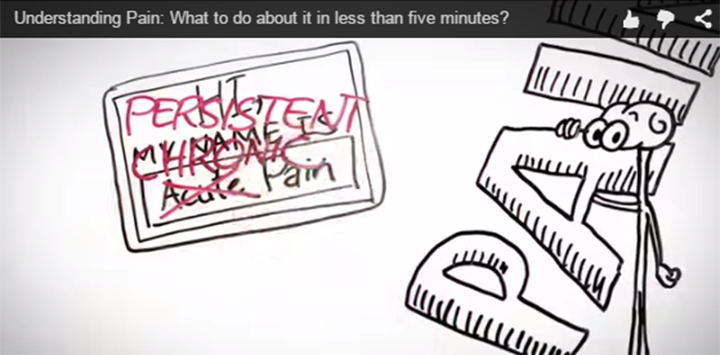Is your persistent pain and how to fix it affecting your relationship?
Brainman videos enable people with chronic pain access to a self-management tool that will help them manage the impacts of chronic pain on their functioning, emotions and interpersonal relationships and will help in the adherence to pain management plans.
This article explores persistent pain and how to fix it. Pain can be debilitating and have a seriously bad impact on your relationship.
Did you know that meditation provides greater reductions in pain intensity and pain unpleasantness than medications like morphine?

This is because persistent pain stems from your brain … and retraining your brain is often one of the best pain-relieving solutions there is.
How Your Brain Causes Pain
As mentioned in the video above, most pain stemming from tissue damage, such as an injury, goes away in three to six months – the time it takes for most tissues to fully heal. More persistent pain (or chronic pain) that goes on even after a physical injury has healed is often the result of a more complex issue, one that stems from sensitivities in your nervous system, including your brain.
If you’ve ever wondered how your body’s aches and pains tie in to brain processes, and how your attitude and emotions can affect them, watch the video above. It’s a complex process that’s still being unraveled, but what is known is that your brain, and consequently your thoughts and emotions, play a key role in your experience of pain.
For instance, meditation appears to work for pain relief because it reduces brain activity in the primary somatosensory cortex, an area that helps create the feeling of where and how intense a painful stimulus is. Laughter is also known to relieve pain because it releases endorphins that activate brain receptors that produce pain-killing and euphoria-producing effects.
Other research has shown that in people with chronic pain, a front region of the brain cortex mostly associated with emotion never shuts off. The brain region remains in active mode, which eventually wears out neurons and alters the way they connect to one another, potentially leading to permanent damage and pain-related symptoms like depression, anxiety, sleep disturbances, and problems with decision making.
In much the same way that a person can experience phantom limb pain after losing a limb, it’s thought that your central nervous system “remembers” any pain that lasts more than a few minutes at the neuronal level. The memories can become so vivid that the pain persists even after the injury has healed, or re-occurs when it shouldn’t, such as from a gentle touch. Researchers are actually working on ways to ease chronic pain by erasing neuronal memories using capsaicin, the active ingredient in hot peppers… but addressing your emotions using mind-body therapies may work just as well.
Rewiring Your Brain for Pain Relief
I’ve mentioned meditation and laughter, but these are just two examples of a burgeoning new field looking at mind-body therapies to address chronic pain.
Sean Mackey, chief of the division of pain management at Stanford, and colleagues recently received a $9-million grant from the National Center for Complementary and Alternative Medicine to look into some of these very approaches. At Stanford University’s Neuroscience and Pain Lab, people are able to watch their brains’ reaction to pain on a screen, and then consciously learn how to control it.
The Wall Street Journal reported:
” …subjects can watch their own brains react to pain in real-time and learn to control their response—much like building up a muscle. When subjects focused on something distracting instead of the pain, they had more activity in the higher-thinking parts of their brains. When they “re-evaluated” their pain emotionally—”Yes, my back hurts, but I won’t let that stop me”—they had more activity in the deep brain structures that process emotion. Either way, they were able to ease their own pain significantly …
That doesn’t mean that the pain is imaginary, experts stress. In fact, brain scans show that chronic pain … represents a malfunction in the brain’s pain processing systems. The pain signals take detours into areas of the brain involved with emotion, attention and perception of danger and can cause gray matter to atrophy …
The dysfunction “feeds on itself,” says Dr. Mackey. “You get into a vicious circle of more pain, more anxiety, more fear, more depression. We need to interrupt that cycle.””
This is where techniques such as distraction can be so effective for pain relief, as can other options like guided imagery, hypnosis and Tai Chi.
Knowing how to control persistent pain and how to fix it is one of the most important steps in rebuilding your relationship.
When you’re trying to fix your relationship but your emotions are out of control, you will always end up fighting. It’s time to get some professional help.
You can change this today.
I can help you to:
- Grow your emotional skills – emotional skills are far more important than any functional skill in achieving a high level of peace and calm within oneself.
- Know your emotional style – your emotional style effects how you react in emotional situations.
- Understand your emotional brain – learn how your brain effects your personal emotions.
—— A GREAT MARRIAGE STARTS WITH YOU ——

